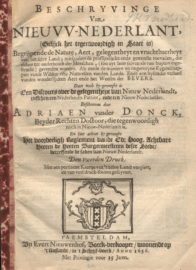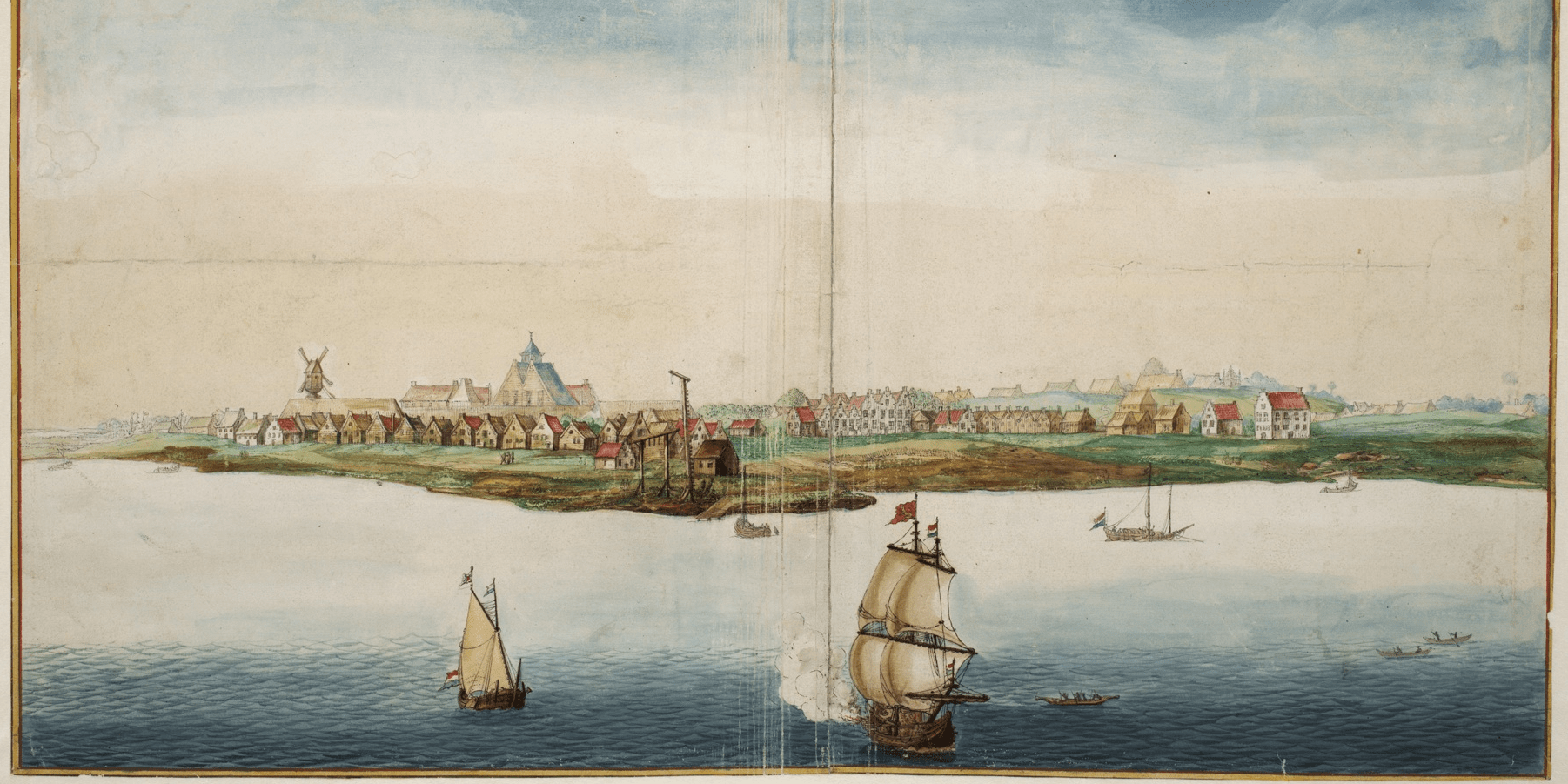In this first installment of a three part blog series, Russell Shorto writes about his experience with the New Netherland archives.
Since the Dutch founded one of the original European colonies in America, and since its capital was none other than a little island called Manhattan, it might be reasonable to suppose that Americans would be brought up with the idea that “Dutch” is as much a part of their heritage as “Pilgrim.” But of course that isn’t true. People may have some inkling that the Dutch once fiddled around in New York. They might even know that it was originally called New Amsterdam. But they tend not to put the Netherlands alongside Britain as one of America’s cultural forebears.
One reason for that is contained in the truism that history is written by the winners. An English invasion force took over the Dutch colony of New Netherland in 1664. The English and the Dutch were at the time bitter rivals. The English, not to put too fine a point on it, hated everything Dutch. All the derogatory sayings in the English language involving the word Dutch-Dutch treat, Dutch courage, double Dutch–date to this period. One of my favorites of the many anti-Dutch pamphlets published in England in the seventeenth century has this for a title: The Dutch-mens Pedigree, Or, A Relation Shewing How They Were First Bred and Descended from a Horse-Turd Which Was Enclosed in a Butter-Box.
 So the English, once they took over Manhattan Island, weren’t about to give the Dutch credit for anything they had done there before. Nevertheless, they did take possession of the thousands of pages of official records of New Netherland, and they kept them. All conquerors do this, because it allows for continuity. Still, those records had a fitful existence. In 1685, after King James ordered a reorganization of the American colonies, the volumes were tossed onto a stagecoach bound for Boston; three years later they made the same rough trip back to New York when the new monarchs, William and Mary, reversed the ruling. Some volumes were lost on these journeys. In 1741, the fort where the records were housed was torched in what was held to be a slave conspiracy. The gatehouse burned, but the records were saved by a diligent secretary tossing them out the window. It was a blustery day, and many pages blew away, but the bulk of the records remained intact.
So the English, once they took over Manhattan Island, weren’t about to give the Dutch credit for anything they had done there before. Nevertheless, they did take possession of the thousands of pages of official records of New Netherland, and they kept them. All conquerors do this, because it allows for continuity. Still, those records had a fitful existence. In 1685, after King James ordered a reorganization of the American colonies, the volumes were tossed onto a stagecoach bound for Boston; three years later they made the same rough trip back to New York when the new monarchs, William and Mary, reversed the ruling. Some volumes were lost on these journeys. In 1741, the fort where the records were housed was torched in what was held to be a slave conspiracy. The gatehouse burned, but the records were saved by a diligent secretary tossing them out the window. It was a blustery day, and many pages blew away, but the bulk of the records remained intact.
During the American Revolution the records spent a good deal of time on a ship in New York Harbor. Mold set in. Then they were shipped to England and spent the last portion of the war in the Tower of London. When they were returned, the secretary of New York State reported that they were “much mill-dewed and greatly injured.” But he tried to stop the damage, using state-of-the-art methods: he directed, he said, “my best endeavors to preserve them, having frequently exposed them to the sun and air, and several times had them brushed through every leaf.”
Then in 1818 the state decided that it ought to have a full English translation. The man selected for this work—Francis Adrian van der Kemp, an elderly Dutch minister and former soldier who had emigrated to New York—translated all 12,000 pages, within four years, and despite the fact that he was going blind, and that his English was not very good. The result was a translation that was in a sense worse than worthless, for it was riddled with errors and yet it became the standard way for historians to learn about the colony. Eventually, mercifully, this translation itself burned up in a fire.
Then in 1974 a true and proper translation and publication effort got underway. The archives were now housed in the New York State Archives and Library, in Albany. Charles Gehring, a young American with a doctorate in Germanic linguistics with a specialization in 17th century Dutch, was hired for one year. Then another. Then another. In late 2016, he is still at it. He and Janny Venema, a Dutch historian who has been his transcriber for the past 30 years, have worked their way through more than half of the material. A community of historians and researchers have built up around the translation and publication effort of the New Netherland Institute. In 1999, the 12,000 pages of manuscript records of the Dutch colony were declared a national treasure by the U.S. Department of the Interior. Besides giving the moldy pages a belated dignity, the designation also came with funds to help preserve them.
 I began my interaction with these materials in the year 2000. I had thought to write a magazine piece about the Dutch founding of New York; someone put me in touch with Charles Gehring. He suggested I come up to Albany the following month, when he would host his annual seminar on the Dutch colony. I did. After meeting with several of the people working on the material, I decided to write a book on the colony. Charles Gehring and Janny Venema cleared a corner of their office for me. They gave me access to the records, and help in deciphering them. I needed a lot of help, since the documents were written in 17th century Dutch (which is quite different from modern Dutch) and in handwriting that to the untutored eye looks something like a cross between Arabic and chicken scratch. I spent hours and hours in that corner of the office, occasionally looking out on downtown Albany but otherwise staring at the antique pages.
I began my interaction with these materials in the year 2000. I had thought to write a magazine piece about the Dutch founding of New York; someone put me in touch with Charles Gehring. He suggested I come up to Albany the following month, when he would host his annual seminar on the Dutch colony. I did. After meeting with several of the people working on the material, I decided to write a book on the colony. Charles Gehring and Janny Venema cleared a corner of their office for me. They gave me access to the records, and help in deciphering them. I needed a lot of help, since the documents were written in 17th century Dutch (which is quite different from modern Dutch) and in handwriting that to the untutored eye looks something like a cross between Arabic and chicken scratch. I spent hours and hours in that corner of the office, occasionally looking out on downtown Albany but otherwise staring at the antique pages.
Fortunately, I didn’t have to rely on my own abilities to decipher them. Gehring and Venema had published at that time 18 volumes of translations. Plus, the two people who knew more about this material than anyone else on earth were right there, ready to answer questions. This was before Google, but it was better than Google. I was able to interact with these actual pieces of 300 year old rag paper, to get to know the various writers through their handwriting, and at the same time I had guides to it all.
What came through–what comes through for anyone who sits with this material and has the patience to work with it–is the human reality of this corner of the past. Up from the pages rise Peter Stuyvesant, Adriaen Van der Donck, Pieter Minuit, Catalina Trico, Joris Rapalje, and hundreds of other people who settled New York before it was New York. You come to know them. You know their secrets, their longings, their schemes. It dawns on you, over time, that the seething atmosphere they created–in which everyone is doing business, everyone is buying or selling beavers, everyone has a piece of the next voyage, everyone wants a piece of the action–has never left the island. The Manhattan they created is still there on paper. And it’s still there in the world’s most magnetic city.

Russell Shorto is an American historian, journalist and author. In 2004, he published The Island at the Center of the World: the Epic Story of Dutch Manhattan and the Forgotten Colony that Shaped America, for which he spent many hours in the New Netherland archives. Between 2008 and 2013, he lived in Amsterdam, where he was the director of the John Adams Institute.
The next two installments of this series will be published on December 12 and December 19.
